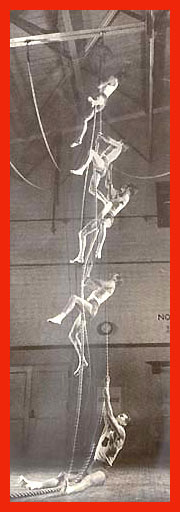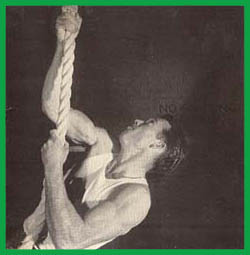|
Description of The Event . . . .
. .
  Climbers
ascended a
1.5 " diameter natural fiber rope, starting in a seated position on the
floor with legs outstretched - the rope lying on the floor between
them. The length of the rope varied - in Olympic competition it was 8
meters long except when the Games were held in the USA:
then a 25
foot (7.62 meters) rope was used. In America the
AAU and NCAA apparently sanctioned competition on
both a 20
foot and a 25 foot
rope. Climbers
ascended a
1.5 " diameter natural fiber rope, starting in a seated position on the
floor with legs outstretched - the rope lying on the floor between
them. The length of the rope varied - in Olympic competition it was 8
meters long except when the Games were held in the USA:
then a 25
foot (7.62 meters) rope was used. In America the
AAU and NCAA apparently sanctioned competition on
both a 20
foot and a 25 foot
rope. Garvin
Smith & Elmer Huckins
The climber leaned back and executed an explosive pull and surge upward, kicking the legs as he strode up the rope, using hands only. You were allowed to kick your legs - a smooth but energetic "stride" - but could not use legs or feet on the rope or to push off the floor. The first move gave the momentum for the rest of the climb. Coming down - not part of the contest - was hand-overhand. The climber never used feet or legs on the rope. Garvin Smith  There
was a flat plate,
or tambourine,
coated
with lamp-black at the top of the rope that you were required to reach
up and touch. When you got back to the floor, you showed the smudge on
your fingers to the timers.
Climbers were timed by manual stopwatch. This was a major
problem, for it took several timers to time the event -
and their times were averaged in some fashion. Lots of opportunity for
human error. There
was a flat plate,
or tambourine,
coated
with lamp-black at the top of the rope that you were required to reach
up and touch. When you got back to the floor, you showed the smudge on
your fingers to the timers.
Climbers were timed by manual stopwatch. This was a major
problem, for it took several timers to time the event -
and their times were averaged in some fashion. Lots of opportunity for
human error. Garvin
Smith
Ironically, an automated electronic timing system had been developed in the mid 1950s by a graduate engineering student at Georgia Tech, but not adopted. If I remember correctly the device used a reconfigured electric wall clock, and the wood pan (with lamp-black) at the top of the rope was simply covered by a thin metal electrostatic shell. Notice how Garvin Smith, a world champion from the 1940s and 1950s, leans back with an open body as he starts the climb from a seated position on the floor. The strength necessary to do this effectively is similar to the strength required to do a front lever on the still rings. Photos courtesy Life Magazine
May 17, 1948 |